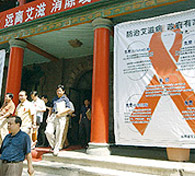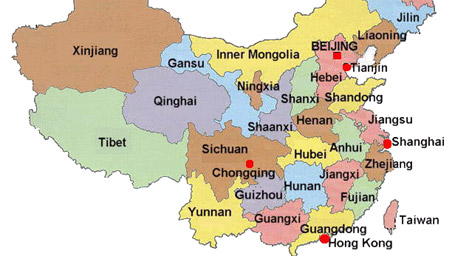In the first instalment of this two-part series exploring AIDS in China, Kenneth Tan looks into the history of the disease in the world's most populous nation, and offers insight into the winds of change that have come upon China. The second instalment, which will be published tomorrow, will examine the issues surrounding the fight against AIDS among men who have sex with men (MSMs) in the country.
When AIDS was first discovered in 1981, nobody knew how greatly it would impact our world, and how many millions of lives it would change. Today, over 20 million lives have been lost and over 40 million people are now living with HIV, the virus that causes AIDS. In 2003 alone, the latest year for which statistics are available, AIDS claimed the lives of 3 million men, women and children.
While encouraging signs are starting to appear in parts of Africa which has been hit the hardest, experts are already pointing to Asia, with half of the world's population, as the next big frontier in the fight against AIDS. The greatest challenge will come from countries like China, India and Indonesia, some of the world's most populous nations.
China's official Xinhua news agency says the estimated number of HIV carriers in China reached 840,000 by the end of 2003, but activists say the extent of the outbreak is far higher. Health agencies have repeatedly warned that China could have as many as 10 million victims by 2010 if it fails to take the threat seriously.
The history and evolution of AIDS in China
AIDS first emerged in China in 1985 in Yunnan province, which now accounts for a third of the country's cumulative HIV cases. That proportion was 50 percent in 2000. Thanks or no thanks to Yunnan's highly mobile population, the HIV has now spread to every Chinese province, causing Yunnan's share in overall HIV incidence in China to drop steadily year by year. With a floating population estimated at 120 million and a high degree of mobility within and across provincial borders, the non-stop movement of people from state to state and from rural to urban areas fuelled the rapid spread of the HIV.
In the early days, the HIV was mostly spread among intravenous drug users. Eighty percent of China's illegal drug traffic passes through Yunnan, which lies just north of the Golden Triangle. Chinese research on the genetics of the HIV (of which there are five strains in China) has shown that the virus has spread along the main drug routes from Yunnan through Sichuan and Gansu to Xinjiang as well as from Yunnan eastwards to Guangdong province. Eighty percent of illegal drugs in China are distributed through Yunnan.
Many villages are also suffering the consequences of commercial blood schemes in the mid-1990s which recycled infected blood among peasant donors. The sale of blood was a quick source of income for many of the poor villagers, but was often carried out in extremely unhygienic conditions. This scandal, covered up for many years by the Henan health authorities, which had encouraged the blood collection, is now acknowledged by the central government in Beijing. Activists say that as high as one million people may have been infected by the botched blood collection schemes in Henan and surrounding provinces.
Today, the nature of transmission has evolved to include other forms of high-risk activities such as prostitution (conservative estimates put the number of prostitutes at six million) and homosexual sex. China is at a crucial point in the AIDS crisis as the disease is now leaping out of marginal infected groups and entering the mainstream population.
Stigma
In a country where sexuality remains largely a taboo subject, stigma is a key barrier to HIV prevention. Discrimination against people with HIV/AIDS remains entrenched in a large part of society.
Fears of family rejection, loss of job, and public ostracisation stymie AIDS prevention efforts in this deeply Confucian society. This discourages those infected with the HIV from seeking needed services because in the process of doing so, their HIV status may be revealed to their family members, colleagues, or community.
Overcoming stigma and discrimination is crucial to China winning the war against AIDS, says Koen Vanormelingen, chief of the Health and Nutrition Section of the United Nations Children's Fund (UNICEF) Office for China.
Vanormelingen adds, HIV/AIDS is not only a health issue, but also a social one. The removal of the stigma attached to it needs the efforts of the whole of society, especially the government and senior leaders.
Winds of change at the top
Not long after the SARS crisis last year, as various activities were launched nationwide to mark World AIDS Day, Chinese Premier Wen Jiabao became the first top Chinese leader to shake hands with AIDS patients. Wearing a red ribbon, Wen paid a widely televised visit to Ditan Hospital, arguably China's most advanced AIDS hospital, and called on the government at all levels to strengthen AIDS prevention and treatment.

Lessons learnt from SARS
From all reports, it does seem as though the SARS epidemic has taught Chinese leaders a valuable lesson about the perils of ignoring a public-health threat, and helped to put AIDS on the Chinese political agenda. China is finally emerging from a period of denial that has set it back several years in the combat against AIDS, and getting its act together.
"SARS had a very positive effect on the situation for HIV/AIDS. Earlier on, there were a lot of amateur efforts. Activists and nongovernmental organisations (NGO's) were trying to do little things, but what's needed is a comprehensive, strategic national plan. Now [Chinese policymakers] are either there or getting there," says John Liu, a consultant to CHAIN, the China HIV/AIDS Information Network, an NGO based in Beijing.
Today there is a limited but growing number of Chinese government-affiliated groups, foreign-government-funded projects, NGO's and United Nations-commissioned agencies working to fight against AIDS in China. Nevertheless, the epidemic, dubbed "China's secret plague" by TIME magazine - along with its associated mortality rates and societal impacts - is spreading much faster than the rate at which programmes are being implemented.
Implementation problems
Contrary to what many Western human rights activists believe, the greatest hindrance to China's effort in combating the virus is not its socialist system but the highly bureaucratic nature of its government.
Though the Chinese central government is making good progress towards HIV/AIDS prevention and care, some local officials and the public still need to pay more attention to the issue, says Vanormelingen. In his trips around China, Vanormelingen has met many local officials who still feel the problem is some distance away, when it is actually on their doorsteps.
And while multinational companies have played a huge role in places like Southeast Asia and Africa in the fight against AIDS, they have been much slower in stepping out in China for fear of riling government officials.
Already, some individuals have paid a high price for speaking too loudly about AIDS. In July this year, Amnesty International reported that four people, all HIV-positive, were detained in Shangqiu city of Henan province after they tried to protest against inadequate healthcare and welfare services for those infected with HIV/AIDS in the city. In similar cases in Shangcai county of Henan, others have been reportedly detained in connection with protests and disturbances relating to lack of access to medical care in the county.
There is no doubt that in a country as large and diverse as China, the impact of policies set by the central government will take time to trickle down to the local areas. And, as with most issues in China, official practice always varies from town to town, city to city, and province to province.
Yet, hope remains if China displays the same kind of resolve it exhibited in its fight against SARS.
And if its people continue to speak up.
The second instalment of this two-part series to be published tomorrow will examine the issues surrounding the fight against AIDS among men who have sex with men (MSMs) in China.












 Printable Version
Printable Version











Reader's Comments
Be the first to leave a comment on this page!
Please log in to use this feature.